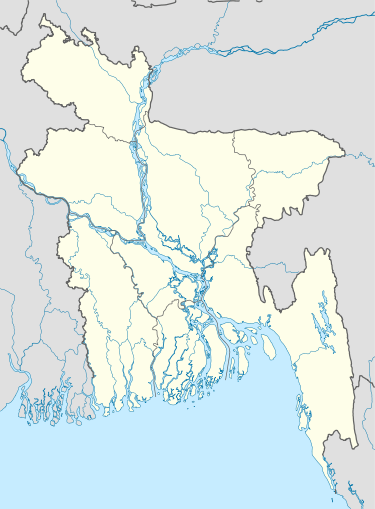Durgapur Upazila, Netrokona
| Durgapur দূর্গাপুর | |
|---|---|
| Upazila | |
 Durgapur Location in Bangladesh | |
| Coordinates: 25°7.5′N 90°41.3′E / 25.1250°N 90.6883°ECoordinates: 25°7.5′N 90°41.3′E / 25.1250°N 90.6883°E | |
| Country |
|
| Division | Dhaka Division |
| District | Netrokona District |
| Area | |
| • Total | 293.42 km2 (113.29 sq mi) |
| Population (1991) | |
| • Total | 169,135 |
| • Density | 576/km2 (1,490/sq mi) |
| Time zone | BST (UTC+6) |
| Website | Official Map of Durgapur |
Durgapur (Bengali: দূর্গাপুর) is an Upazila of Netrokona District in the Division of Dhaka, Bangladesh.
Geography
Durgapur is located at 25°07′30″N 90°41′15″E / 25.1250°N 90.6875°E . It has 32245 units of house hold and total area 293.42 km². Durgapur Upazila is such a unique place where river of clean water, hills, sands make a heavenly natural environment.
History
When Explorers markopolo is at Tatar emperor Kublai Khan’s audience chamber in his mission. The another adventurer Someshwar pathok from kanyakubja of India 1280 AD (686 BS Magh month) east of Mymensingh pahara mulluke northan side 'Kamrup trips, including the walls of the premises of the current dasabhuja Ashok falls down, for the rest of the journey. This' Hills area was under the rule of a oppressive, garo called Baisha Garo. Someshwar pathok defeated him in a war and Beginning a feudal kingdom named Susang. This Someshwar pathak was the founder of susanga dynasty. After 300 years later finally these men of the royal dynasty was called to contain Singho. This worthy successor dynasty wrestler and a keen knowledge of diplomatic Raghunath Singh made an agreement with the Mughal Emperor Akbar when he Ascended to the power of Dilli . As part of this agreement on behalf of manasingho is to take part in the war against Kedar Ray, Chand ray of bikramapur. After defeating Chand Roy and Kedar Roy King Raghunath return from ther with one of eight metals fetish of Devi durga , and the royal temple of Durga placed today known as the Temple of dasabhuja. Since then, with the Susongo by adding Durgapur This region is named susanga Durgapur. Late nineteenth century to work without payment in banished of elephants, Hajong tribals was protesd. Revolts led by a leader named Mona Sordar. Tanka movement led by Comrade Moni Singho in 1942-43. In 1971 the peoples of susang durgapur have a great sacrifice. Durgapur was free in 6 December 1971.
Demographics
At the 1991 Bangladesh census, Durgapur had a population of 169,135, of whom 83,795 were aged 18 or older. Males constituted 50.49% of the population, and females 49.51%. Durgapur had an average literacy rate of 23% (7+ years), compared to the national average of 32.4%.[1]
Ethnic composition of Durgapur Thana
Durgapur is rich in a diversity of indigenous peoples, heritage, and culture. Ethnic Composition of Durgapur Thana (In Alphabetical Order) is given below:
Source: Small Ethnic Groups of Bangladesh: A Mapping Exercise; By: Mohammad Rafi; Panjeree Publications; Year: 2006
Total Households: 8,250
1. Banai; Total Village: 1; Total Household: 6; Language Practiced: Banai; Religion Practiced: Hinduism;
2. Bangali; Total Village: 48; Total Household: 4,778; Language Practiced: Bengali;
3. Buna / Buno; Total Village: 3; Total Household: 37; Language Practiced: Bengali; Religion Practiced: Hinduism; Buna / Buno in Other Districts: Dhaka, Gazipur, Mymensingh, Rajbari, Sherpur, Tangail, Bagerhat, Jessore, Jhenaidah, Khulna, Kushtia, Magura, Satkhira, Bogra, Dinajpur, Joypurhat, Naogaon, Natore, Nilphamari, Pabna, Rajshahi, Sirajganj, Maulvibazar;
4. Garo; Number of Villages they lived with bangali: 10; Total Household: 924; Language Practiced: Achik / Garo (98.08%), Deal (1.92%); Religion Practiced: Christianity (99.96%), Shangsharik (0.04%); Garo lived in Other Districts: Sherpur, Mymensingh, Banderban, Chittagong,
5. Hajong; Number of Villages they lived with bangali: 08; Total Household: 505; Language Practiced: Hajong; Religion Practiced: Hinduism; Hajong in Other Districts: Mymensingh, Sherpur, Sunamganj;
The city's area is 293.42 sq kimi It has 9 wards, and consists of 7 mahallas. It is an ancient town situated on the banks of the river somessori. This habitation known as a tourist area. There are civil and criminal court here from British rule regime. Durgapur Thana was formed in 1874 and converted into upozila was 1982.
Paurasabhah 1 (Durgapur Headquarters) Union 7 Maujah 134 Village 205 population Density 710 (per sq km) literacy in rate Village in village 31.0% and in town 52.3% Population of the town 22661 and village 175665
See also
References
- ↑ "Population Census Wing, BBS.". Archived from the original on 27 March 2005. Retrieved 10 November 2006.
- ↑ https://bn.wikipedia.org/wiki/%E0%A6%A6%E0%A7%82%E0%A6%B0%E0%A7%8D%E0%A6%97%E0%A6%BE%E0%A6%AA%E0%A7%81%E0%A6%B0_%E0%A6%89%E0%A6%AA%E0%A6%9C%E0%A7%87%E0%A6%B2%E0%A6%BE#cite_note-bp-1
- ↑ http://eduguardian.com/institute/bangladesh/dhaka/netrakona/national-university-college/1388-susang-college-durgapur-netrokona
External links
- - Banglapedia: Durgapur Upazila
- - "Bangladesh Government District Portal for Netrokona"
- - "Shusung Mahabidyalaya"
- - "Durgapur Mohila (Women's) Degree College"
- - Facebook Group: "Shusong Durgapur, Netrokona", a community portal with comprehensive information about Shusong Durgapur and Its People, as well information on Tourism, Travel, Accommodation, etc.
